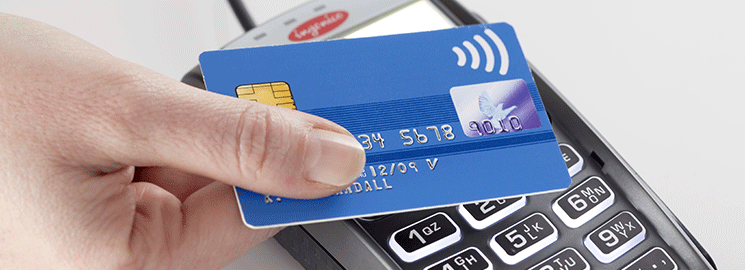While waiting in line at the grocery store you may have noticed a new way to pay for your items these days as it seems like customers have been magically waving their credit or debit cards over a pay terminal without having to manually select an account or even punch in their password. Its called contactless payment and its latest high-tech way to pay.
For anyone who does not know much about this type of payment service, contactless payment is a very fast and convenient wireless payment technology that requires no physical connection between the consumer card and the POS terminal. It works on a wireless radio frequency called RFID (radio-frequency identification) or NFC (near field communication) and so on most new credit or debit cards issued by your bank these days, (though I think you still have to request and sign to have this option on your card at the bank because of potential security issues) you will notice a small chip embedded into your card that will act as a radio antenna which gets activated when you wave it very close to the POS terminal. From there the terminal will wirelessly communicate with your card, in an encrypted and safe way, in order to exchange payment without you having to punch in a password, select an account or even payment type. This technology does make for a very fast and convenient way to pay.
This payment option has been around in Canada for many years but only recently it seems like a lot of venders have updated their POS terminals to support it. It’s easy to spot a contactless bank card or POS terminal by the radio wave symbol on the front along with Visa payWave™, MasterCard PayPass™ or Interac Flash™ stamped on the terminal as well. Most grocery, gas, and coffee places now support it and the statistics are saying that line waiting times are a lot less and vendors are happier since people who use contactless payment tend to spend more.
Contactless card transactions are processed through the same secure networks used for all other Visa, MasterCard and Interac transactions. Your card never leaves your hand and each transaction has a unique, encrypted code that changes every time the card is used. With that in mind, there have been news reports about electronic pick-pocketing, where a criminal with a card reader, laptop or smartphone can read the information on contactless cards and commit fraud. It’s important to know that contactless cards are embedded with multiple layers of security to protect you, so the chances of you becoming the victim of this type of fraud are unlikely but not impossible.
This is mainly due to the fact that contactless cards can only work within a very short range of a retail terminal, which makes it difficult for criminals to gain access to your card information from any distance.
Also too, during a transaction, the card and the terminal communicate with each other, doing security checks and transmitting a unique encryption code, which expires after the transaction is finished. If someone was able to get close enough to steal data from your card, they would not be able to use the encryption code because it would have expired.
And the information transmitted during a contactless transaction is very limited and includes things like language preference, card number and other coding. The customer’s name, bank account number and the three-digit security code on the back of your credit card are not transmitted during a contactless transaction.
Contactless cards generally have low transaction limits – typically between $50 and $100 – and any larger purchase will require you to enter your PIN.
And finally, it looks like all banks and credit card companies seem to follow a zero liability if you can prove fraud and so you won’t be held responsible for any purchases associated with the fraudulent transactions.
So the bottom line is that contactless payments are definitely a quicker, more convenient way to pay for your items but that convenience can come at a cost – like most stuff digital convenience tends to lower the security level – although Apple and Google pay via your smartphone fingerprint reader or watch might change the way we view contactless payments when mobile payment technology arrives here in Canada.

